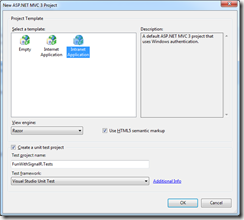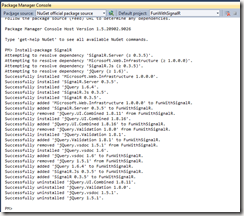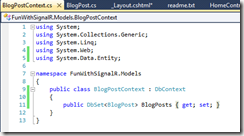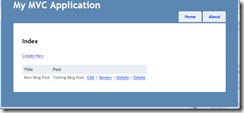I recently co-wrote a new article with Suprotim Agarwal in the DNC Magazine. If you are a .NET Dev I strongly recommend you subscribe to this Free Bi-monthly Magazine. The source code for the article is on Github Repository of DotNetCurry. You can see the sample live here.
Background
For the past several months I have noticed David Fowler, Damien Edwards, Phil Haack and a few other MS Techies I follow on twitter, tweet excitedly about a new framework called SignalR. I didn’t understand the excitement fully and to be honest didn’t try too hard to figure out.
Yesterday Scott Hanselman published this article and re-distributed a link to an article which he wrote end of August, 2011. After going through both, I really wanted to take a closer look at SignalR, and while trying to get his ‘…monkey typing Shakespeare…’ code working I finally had the ‘Ah ha!’ moment.
I just had to come up with this quick and dirty sample to demonstrate a use for SignalR and since I want the bragging rights for it, I am going to throw it up as is without bothering about the niceties of a Nuget package or sample.
The Idea
First time I saw Google Wave’s technology demo where they showed multiple people editing/reviewing the document at the same time, it blew me away. I was fascinated by it, but told myself I was too ‘javasciptically challenged’ to design such an Async client side framework.
When my tubelight** finally came on, SignalR was the obvious way to do it. Following is my first rough cut that as of now only syncs content. We’ll get to the fancy colored carets at a later point (hopefully in another article).
**In India one is referred to as a tubelight if something strikes late. Back in the days of non-electronic ballasts for fluorescent lighting, the tubes used to flicker for few seconds before turning on.
Please go through Scott’s articles or SignalR documentation to understand SignalR better. I make no attempts to explain SignalR here (partly because I know precious little and partly it’s such a fantastic framework that you need very little up front to get going).
Head-first into SignalR
To build a scaffolding for SignalR framework you can use plain html with a backend server side SignalR Hub class as Scott demonstrated. But I chose to start off with an ASP.NET MVC 3 project. (Actually my first attempt at ASP.NET MVC 4 using VS 2011 Dev Preview didn’t quite go so well, so I rolled back to the stable releases of ASP.NET MVC 3 on Win 7 using VS 2010).
Setting up a support app as an ASP.NET MVC 3 web project
I called it ‘FunWithSignalR’ and set it up as an Intranet Application
Adding SignalR to your project using Package Manager Console
The package manager console helps you download Nuget packages among other things. If you don’t have it visible you can bring it up from the above menu (in VS 2010)
SignalR is available as a nuget package and all you have to do to include is run the following command in the Package Manager Console
Install-package SignalR
The above command will get all the dependencies you need for SignalR and if your jQuery script files are not up to speed, will get the latest libraries for jQuery too (SignalR client uses jQuery hence the dependency check results in the upgrade). The output will looks something similar to
Update jQuery dependencies in Views\Shared\_Layout.cshtml by pointing to the most recently updated jQuery version. As per above image the latest version for me today is jquery-1.6.4.min.js because that’s the one the package manager installed.
Setup the Code First EF Model
We’ll setup a very simple code first model by adding one Entity called BlogPost in our Model folder.
Add the DbContext for the BlogPost.
Build the solution at this point.
Scaffold the Controller and UI
To use the default scaffold tooling that comes with MVC 3, right click on the Controllers folder and select Add –> Controller.
Select the Template, Model and Data Context values as shown above and click Add.
At this point you will have the scaffolding necessary to Add/Edit/Delete BlogPosts.
Adding the ‘Review’ Action
Open the BlogPostController and Copy paste the Get and Post action methods for the Edit action. Change Edit to Review as shown below.
Copy the Edit.cshtml and paste it in the View folder. Rename it to Review.cshtml
Update the Index.cshtml such that a ‘Review’ link comes up in the Index
Getting SignalR into the game
The Server Side
In your web project create a folder called SignalR (You can call it anything you want, in a real life project this as server side component and could very well reside in a dll of it’s own).
In the SignalR project add a class BlogHub.cs
Add the following code to it
using System;
using System.Collections.Generic;
using System.Linq;
using System.Web;
using SignalR.Hubs;
namespace FunWithSignalR.SignalR
{
[HubName("blogHub")]
public class BlogHub : Hub
{
///
<summary> /// The method called from SignalR client (JS)
/// </summary>
///String Data
///Session ID: Used in this sample to track users
///A boolean value used in the example indicating
/// if incoming value should be appended or overwritten when sent back to
/// other clients
public void Send(string message, string sessnId, bool append)
{
Clients.addMessage(message, sessnId, append);
}
}
}
The Client Side
- Open Review.cshtml and add the following script references
Note: json2.min.js is not packaged with the SignalR nuget. I have packaged it as a part of my code. I got it from Scott’s ‘Shakespeare demo’.
Note 2: /signalr/hubs is dynamically generated at runtime. So don’t worry if it gives a green squidgy right now. It works fine at runtime. Without this reference SignalR client won’t work.
- Change the Html helper for the Post property from Html.EditorFor(…) to Html.TextAreaFor(…).
- Add a hidden field to save the session Id in it (this maybe a security hole, need to investigate best practices)
<input id="sessinId" type="hidden" value="@Session.SessionID" />
- Drop the following script in
<script type="text/javascript">// <![CDATA[
$(function () {
// Proxy created on the fly
var blog = $.connection.blogHub;
// Declare a function on the blog hub so the server can invoke it
blog.addMessage = function (message, sessnId, append) {
var sessId = $('#sessinId').val();
if (sessId != sessnId) {
if (append) {
$('#Post').append(message);
}
else {
$('#Post').val(message);
}
}
};
// Start the connection
$.connection.hub.start();
$("#Post").keyup(function (event) {
// Call the send method on the server
var sessId = $("#sessinId").val();
if (event.keyCode >= 65 && event.keyCode <= 122) {
if (event.shiftKey || (event.keyCode == 32)) {
blog.send(String.fromCharCode(event.keyCode), sessId, true);
}
else {
blog.send(String.fromCharCode(event.keyCode + 32), sessId, true);
}
}
else {
blog.send($("#Post").val(), sessId, false);
}
});
});
// ]]></script>
- If you see closely this is pretty similar to Scott’s 11 lines of code to get a chat client going.
Changes I have made are:
1. Send message to server on KeyUp event of the Post text area, instead of an explicit button push
2. Send more meta information like the current sessionId and if the keystroke means an append action should take place at the client action of an overwrite action should take place at the client option.
Let it Roll
Run the application and navigate to the BlogPost Index
Add a new Post
Click on Review
Press Ctrl+N to start a new browser instance with the same page. Hit F5 so the session id (the text field next to Save button) changes. Arrange the two browsers side by side.
Type in one Post text area and watch the other one change almost simultaneously
As Scott says, Kabooom! brain explodes…..
In Conclusion
To wrap up, we saw how mind numbingly easy it is to use SignalR.
It’s a fantastic abstraction over various techniques available for persistent connections over http. Under the hood it can use websockets or longpolling depending on what’s available.
You can get infinitely creative with it and build fantastic collaborative ASP.NET apps using SignalR backend.
Some day (hopefully) in the near future, I would have overcome my javascript challenges and built a real collaborative editor with all the fancy bells an whistles of Google Docs.
Finally, David Fowler and team, a million thanks for such a fantastic framework. I am loving the ‘just works’ motto ![]() . And Scott Hanselman for providing the ‘Aah ha!’ moment, without which I probably would have not given SignalR a look yet.
. And Scott Hanselman for providing the ‘Aah ha!’ moment, without which I probably would have not given SignalR a look yet.
The Code
The code can be downloaded from here (size 844 KB) (skydrive). It is provided AS IS, with no warranties expressed or implied. You are free to use it without any attribution (but I would love it if you do feed my ego ![]() ).
).
I have now made the code available on bitbucket Mercurial repository. You can get it from here https://bitbucket.org/sumitmaitra/funwithsignalr
Update
The code in bitbucket now uses Google’s diff-match-patch implementation and is hence Apache licensed now.













Very nice walkthrough, Sumit.
When Wave was disbanded, Google open sourced the algorithm that allows two or more people to send updates across at the same time without erasing each other’s changes.
It’s called diff-match-patch and lives here: http://code.google.com/p/google-diff-match-patch/
Wow, thanks @Skovsboll.
The diff-patch-match integration definitely moves to the top of my ‘to tinker’ list :). They, even have a C# lib for it! Sigh! too many good people at Google ;-)…
Cheers,
Sumit.
[…] I think it’s time to abandon the old check-in/out workflow. With components like signalR, a simple Wave-like HTML editor can be done in 30 lines of C# code and 60 lines of JavaScript. In other words, it’s ready to be put into production to replace your CMS publishing workflow today. Sumit Maitra posted a demo of these concepts. […]
I noticed you are using intranet template, why not internet?
Hello Zaia,
The templates should not matter. Both Intranet/Internet templates should work just fine!
What is the status of MVC4 with regards to SignalR? what is the show stopper in MVC4 with regards to SignalR?
Thanks,
Hello Zaia,
When I tried with MVC4 I had a little trouble with the MVC scaffolding. SignalR should work just as is, checkout Hanselman’s article that I have linked to. The issues I faced was probably something to do with my environment. I will give it another shot and let you know what happens.
Very useful article, it really helped get me started, thanks.
With regard to your use of the session id, there is a built in clientId that you can use to track users:
$.connection.hub.clientId in the js and
Context.ClientId.ToString() on the hub
Thanks Jay,
Yeah I discovered the ClientId thingy after I published the post. Have been lazy about updating it. Now that you have caught me, I will do it soon :-).
Cheers,
Sumit.
Great article!! Was having trouble getting it going on MVC until I followed your steps. Hey, you STILL haven’t updated the post to use the ClientId yet? 😉
[…] Fun with @SignalR […]
[…] Fun with @SignalR […]